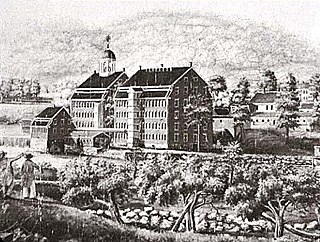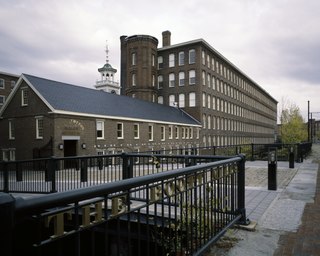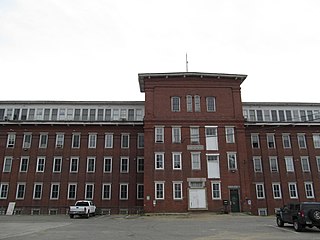
Francis Cabot Lowell was an American businessman for whom the city of Lowell, Massachusetts, is named. He was instrumental in bringing the Industrial Revolution to the United States.

A cotton mill is a building that houses spinning or weaving machinery for the production of yarn or cloth from cotton, an important product during the Industrial Revolution in the development of the factory system.

The Waltham-Lowell system was a labor and production model employed during the rise of the textile industry in the United States, particularly in New England, during the rapid expansion of the Industrial Revolution in the early 19th century.

A three-decker, triple-decker triplex or stacked triplex, in the United States, is a three-story (triplex) apartment building. These buildings are typically of light-framed, wood construction, where each floor usually consists of a single apartment, and frequently, originally, extended families lived in two, or all three floors. Both stand-alone and semi-detached versions are common.

The Boston Manufacturing Company was a business that operated one of the first factories in America. It was organized in 1813 by Francis Cabot Lowell, a wealthy Boston merchant, in partnership with a group of investors later known as The Boston Associates, for the manufacture of cotton textiles. It built the first integrated spinning and weaving factory in the world at Waltham, Massachusetts, using water power. They used plans for a power loom that he smuggled out of England as well as trade secrets from the earlier horse-powered Beverly Cotton Manufactory, of Beverly, Massachusetts, of 1788. This was the largest factory in the U.S., with a workforce of about 300. It was a very efficient, highly profitable mill that, with the aid of the Tariff of 1816, competed effectively with British textiles at a time when many smaller operations were being forced out of business. While the Rhode Island System that followed was famously employed by Samuel Slater, the Boston Associates improved upon it with the "Waltham System". The idea was successfully copied at Lowell, Massachusetts, and elsewhere in New England. Many rural towns now had their own textile mills.

The Amoskeag Manufacturing Company was a textile manufacturer which founded Manchester, New Hampshire, United States. From modest beginnings it grew throughout the 19th century into the largest cotton textile plant in the world. At its peak, Amoskeag had 17,000 employees and around 30 buildings.

The Lowell mill girls were young female workers who came to work in textile mills in Lowell, Massachusetts during the Industrial Revolution in the United States. The workers initially recruited by the corporations were daughters of New England farmers, typically between the ages of 15 and 35. By 1840, at the height of the Textile Revolution, the Lowell textile mills had recruited over 8,000 workers, with women making up nearly three-quarters of the mill workforce.

Mill Conversion or mill rehab is a form of adaptive reuse in which a historic mill or industrial factory building is restored or rehabilitated into another use, such as residential housing, retail shops, office, or a mix of these non-industrial elements (mixed-use).

The Boott Mills in Lowell, Massachusetts were a part of an extensive group of cotton mills, built in 1835 alongside a power canal system in this important cotton town. Its incorporators were Abbott Lawrence, Nathan Appleton, and John Amory Lowell, and is named after Kirk Boott, the first Agent of the Proprietors of Locks & Canals in Lowell. Today, the Boott Mills complex is the most complete remainder of antebellum textile mills built in Lowell. The original Mill No. 6 is managed by the National Park Service unit Lowell National Historical Park and houses the Boott Cotton Mills Museum and the Tsongas Industrial History Center for K-12 educational programs.

The Grover Shoe Factory disaster was an industrial explosion, building collapse and fire that killed 58 people and injured 150 when it leveled the R. B. Grover shoe factory in Brockton, Massachusetts on March 20, 1905. Following a boiler explosion, the four-story wooden building collapsed and the ruins burst into flames, incinerating workers trapped in the wreckage.

David Nevins Jr. was a wealthy Yankee merchant in the city of Methuen, Massachusetts during the industrial boom of the late 19th century.
Harriet Francoeur Nevins was an American philanthropist and animal welfare advocate born in Roxbury, Massachusetts. Widow of David Nevins Jr., she used her inheritance to leave a legacy to the people of the Bay State. She died November 14, 1929, at her home in Methuen, Massachusetts.
George Howe (1819–1899) of Boston was a 19th-century merchant, industrialist, and investor. He was, with David Nevins Sr., co-owner of Pemberton Mill when it collapsed in what is "likely the worst industrial accident in Massachusetts history" and "one of the worst industrial calamities in American history". According to later court testimony reported by The New York Times, Howe escaped just as the structure was falling.
Charles Henry Bigelow of Lowell, Massachusetts was a 19th-century engineer and architect. Born in Watertown, Massachusetts, Bigelow was a graduate of West Point, ranking second in the class of 1835. He married Harriet Briggs, daughter of the late Massachusetts Governor George N. Briggs. He died in New Bedford, Massachusetts in 1862 at the age of 47. On March 31, 1847, Bigelow was one of a group of influential citizens in Lawrence, Massachusetts that founded and chartered the Franklin Library Association, now the Lawrence Free Library. Bigelow was the Association's first president.

Henry Coffin Nevins was an industrialist from an established New England family in the city of Methuen, Massachusetts.

The Merrimack Valley is a bi-state region along the Merrimack River in the U.S. states of New Hampshire and Massachusetts. The Merrimack is one of the larger waterways in New England and has helped to define the livelihood and culture of those living along it for millennia.

The Everett Mills are a group of buildings consisting of the Everett and Stone Mills in Lawrence, Massachusetts. A former cotton textile mill, it was the site of the start of the Bread and Roses strike in 1912 and the one time workplace of Robert Frost.

The Rana Plaza collapse was a structural failure that occurred on 24 April 2013 in the Savar Upazila of Dhaka District, Bangladesh, where an eight-story commercial building called Rana Plaza collapsed. The search for the dead ended on 13 May 2013 with a death toll of 1,134. Approximately 2,500 injured people were rescued from the building. It is considered the deadliest accidental structural failure in modern human history, as well as the deadliest garment-factory disaster in history and the deadliest industrial accident in the history of Bangladesh.

The Salmon Falls Mill Historic District encompasses a historic mill complex on Front Street in Rollinsford, New Hampshire. The complex includes four major structures and seven smaller ones, on about 14 acres (5.7 ha) of land along the Salmon Falls River. They were built between about 1840 and the mid-1860s, and have an unusual architectural unity, for additions made to the buildings were done with attention to matching design elements from the existing structures. The Number 2 Mill, built in 1848, was an early location where a turbine was used instead of a waterwheel to provide power to the mill machinery. The district was listed on the National Register of Historic Places in 1980.

















